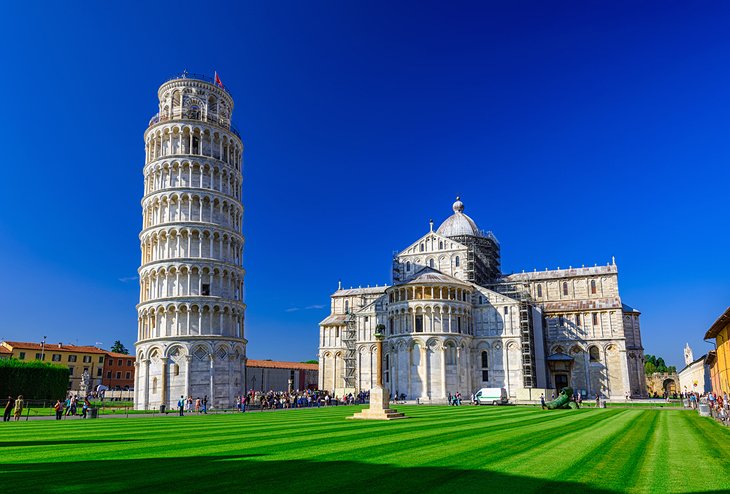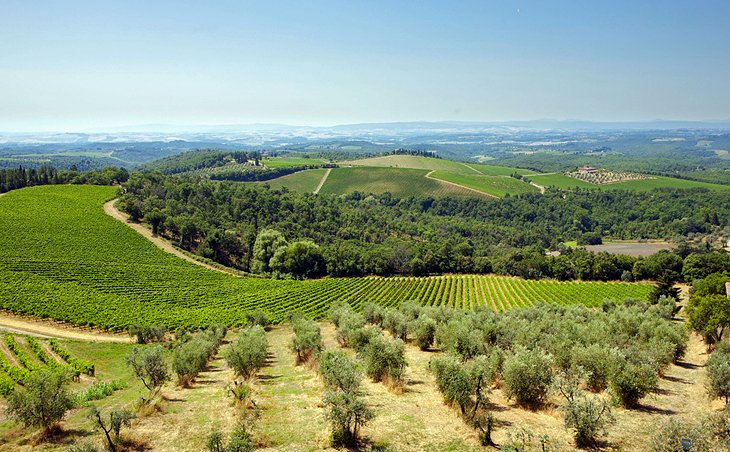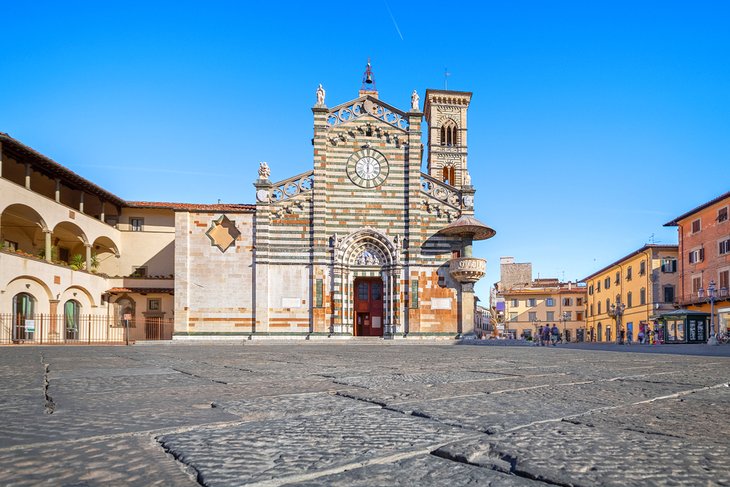
14 Top Rated Day Trips from Florence
Share
With Bologna less than an hour's train ride to the north. Siena to the south, and the combination of Pisa and Lucca to the west. Florence ideally located for tourists exploring the attractions of central Italy.

But even closer than these cities are the Chianti hills, the beautiful rolling Tuscan countryside, and art-filled Prato and Pistoia. You may be surprised at how much of Tuscany you can see in one day of sightseeing; with so many things to do nearby. You'll find plenty of choices in our list of top day trips from Florence.
1. Pisa - one of top day trips you can't miss

The famous Leaning Tower, the Torre Pendente, is one of the most easily recognized icons of Italy. But it's only one of an entire ensemble of outstanding attractions in Pisa. All within a small area that make up its UNESCO World Heritage site. Along with the tower are the Cathedral of Santa Maria Assunta, the Baptistery, and Campo Santo, close together in the Campo dei Miracoli (Field of Miracles).
The tower, a separate bell tower for the cathedral, was begun in 1173 and began to lean almost from the start. The cathedral was begun a century earlier to celebrate Pisa's naval victory over the Saracens. Enlarged and embellished over the centuries it is the definitive example of the Pisan architectural style.
Its artistic highlight is the carved marble pulpit by Giovanni Pisano. But be sure to also see the 13th- /14th-century mosaic in the apse by Cimabue and the bronze doors of the Porta di San Ranieri, with scenes from the lives of the Virgin and Christ. In the adjacent baptistery there's another carved marble pulpit from the 13th-century, a masterpiece of Romanesque sculpture.
Priceless silver masterpieces, embroideries, tombs, sculptures, and paintings are displayed in the Museo dell'Opera del Duomo. Where you can also get the best close-up view of the Leaning Tower. You can visit Pisa from Florence and avoid the long wait to climb the tower on a Pisa Half-Day Trip from Florence Including Skip-the-Line Leaning Tower of Pisa Ticket. Led by an expert guide, the trip includes travel to Pisa through the Tuscan countryside on an air-conditioned coach.
2. Bologna

Only about half an hour from Florence by train, Bologna is one of Italy's most appealing cities for tourists. Known for its good food, it is also a city of beautiful arcades that line its streets and provide shelter from the summer sun. Fine old shopfronts, restaurants, and cafés hide underneath the columned passages, making Bologna a favorite city for shopping.
Although not as famous as Pisa's, Bologna's tall brick towers lean at more alarming angles. And the perception is magnified by their height and slender construction. Twenty of the original 100-plus towers remain, and you can climb to the top for views. At the center of Bologna are the broad Piazza Maggiore and Piazza del Nettuno, named for the 16th-century fountain, among the finest of its period.
Overlooking Piazza Maggiore is the still unfinished facade of the great Basilica of San Petronius. This is only one of Bologna's interesting and art-filled churches; Santo Stefano is the oldest of these and the most atmospheric.
3. Siena - top day trips in Florence

In the 13th and 14th centuries, Siena was a major rival to Florence in its wealth and power and also for its art and architecture. Its artists rivaled those of Florence, as you can see from the magnificent cathedral, one of Italy's finest examples of Gothic architecture.
Throughout the city are more premier examples of Gothic churches and palaces. Most of them constructed of bricks made from Siena's characteristic red clay. Alternating stripes of dark and light marble cover the façade and walls of Siena's cathedral. Further adorned by statues and reliefs, all the work of famed artist Giovanni Pisano.
Inside is a veritable museum of artworks by Nicola and Giovanni Pisano, Donatello, Lorenzo Ghiberti, Bernini, and others. Whose paintings, sculptures, carvings, frescoes, stained glass, and gold work fill the church and its chapels, crypt, library, and museum.
Just walking through Siena's narrow medieval streets is a pleasure. But be prepared for some climbing, as the city is built on hills. Even its main square, the huge Piazza del Campo where the famous Palio horse race is held, slopes downhill.
4. Lucca

Unlike most walled cities in Europe, the walls around Lucca are not medieval but were built in the Renaissance era, in the 16th century. Built wide to support heavy artillery and planted with trees to help support the earthwork. The walls made a perfect promenade in the 19th century, when they were no longer needed for defense.
Today, they are one of this charming small city's greatest attractions. There's plenty more to see and do here: an oval piazza surrounded by tall houses that were built into the walls of a Roman arena. Churches filled with priceless art, the home of operatic composer Giacomo Puccini. And some of Tuscany's most beautiful examples of Romanesque architecture.
The foremost Romanesque church is San Michele in Foro, and don't miss climbing the tall Guinigi Tower. Where there's a tree-shaded mini park at the top.
5. Cinque Terre - one of top day trips in Florence

The five picturesque villages that stud the steep hillsides and cliffs above the Ligurian Sea have taken on an iconic status. Monterosso al Mare, Vernazza, Corniglia, Manarola, and Riomaggiore are joined by a railroad that burrows through the headlands between them. And by a trail skirting the vine-cloaked fields, and in places, carved into the steep cliffs.
Even though they are popular with tourists . The villages of the Cinque Terre retain their feeling of remoteness and their charming, narrow lanes lined by colorful houses. Tiny harbors protect fishing boats, and some offer places to swim between hikes.
The land and culture of the Cinque Terre is protected as a national park and has been designated a UNESCO World Heritage Site. Without the traditional must-see sights, churches, or museums, it's the Cinque Terre's natural beauty and carefree atmosphere that are the attraction.
An easy way to get there is on a Cinque Terre Semi-Private Day Trip from Florence a full day that includes round-trip travel in an air-conditioned minivan. A cruise between Manarola and Vernazza, entrance fees to the coastal walking path, and time to explore the villages. A maximum of eight people guarantees personal service.
For a more active experience, join the Cinque Terre Hiking Day Trip from Florence to hike a 5.5-kilometer stretch of the famed Cinque Terre walking path between towns with a guide. The tour includes a 40-minute boat ride along the Riviera, a train ride between towns, time for a swim, and transport from Florence on an air-conditioned coach.
6. Monti del Chianti (Chianti Hills)

A drive through the Monti del Chianti takes you through some of the most attractive scenery in Italy. The Chianti Hills, with their olive groves and woods of chestnut and oak, lie between Florence and Siena, and Route 222, the Via Chiantigiana, twists and turns through this region.
Greve, in the heart of the Chianti Classico region, has an impressive piazza lined with arched colonnades. And beyond Greve, the landscape grows even more picturesque. An outstanding viewpoint is from the medieval fortress in Castellina.
7. San Gimignano

Easy to recognize from its skyline bristling with medieval towers, San Gimignano is the postcard village of the Tuscan hill towns. At its height in the Middle Ages, San Gimignano was a stop on the Via Francigena, the main pilgrimage route to Rome. And when the flow of pilgrims slowed in the late Middle Ages, the town became a nearly forgotten backwater.
As a result, its medieval towers, walls, and churches were not torn down to make room for new development. So 13 of its original 70 towers, its largely intact 13th-century walls. The Romanesque Knights Templars' Church of San Iácopo, and even a 14th-century Herb Pharmacy and Herbarium remain for tourists to enjoy.
San Gimignano is about 50 kilometers southwest of Florence. And not far from the less-visited hill town of Volterra, so the two are easy to combine on a day trip.
8. Assisi

Although most tourists have heard of Assisi because of its connection with St. Francis of Assisi. And many make the trip as part of a pilgrimage or religious tour, they are often surprised to find that Assisi is far more than the popular saint. Because of his presence and legacy, Assisi attracted the great artists, inspired to commemorate his work with their own.
The Basilica di San Francesco, built over the saint's tomb in the early 13th century. It's one of the world's most important pilgrimage sites, decorated over the centuries by artists including Giotto, Cimabue, and Andrea da Bologna. The town's Cathedral of San Rufino, from the 12th and 13th centuries, has outstanding early medieval stone carvings of animals, mythical beasts, foliage, and saints.
Convent of Santa Chiara and the 9th-century church of Santa Maria degli Angeli have St. Francis connections, as well. You can combine a tour of Assisi with a visit to the charming nearby Umbrian town of Cortona on an Assisi and Cortona Day Trip from Florence that includes stops at the Basilica, Convent of Santa Chiara, and Santa Maria degli Angeli.
9. Pistoia

It's the abundance of remarkable medieval churches that attract tourists to Pistoia, about halfway between Florence and Lucca. For a relatively small city, it has more than its share of outstanding art from the Middle Ages.
Begin at the Cattedrale di San Zeno, built in the 12th to 13th century. Whose facade and arched portico is decorated with panels of majolica and a glazed terra-cotta lunette by Andrea della Robbia.
From the main church, you can enter the Cappella di San Iácopo to admire a magnificent silver altar that shows a succession of styles from Early Gothic to Renaissance. Opposite the cathedral is the 14th-century baptistery. Designed by Andrea Pisano in alternating bands of white and green marble, and a small rose-window.
10. Arezzo

Only about 80 kilometers from Florence, the town of Arezzo was a Roman outpost, but dates back to Etruscan times. You'll find reminders of all these eras in its museums and churches, along with art by some of Italy's great names.
Cimabue worked in Arezzo; the architect/artist Vasari lived here; and Andrea della Robbia, Piero della Francesca. And Nicola Pisano all contributed to its treasury of medieval and Renaissance art. The cathedral is especially known for its remarkable stained-glass windows and the frescos in the church and sacristy.
11. Prato

Less than 25 kilometers from Florence, Prato is a center for art, both historic and contemporary. The choir of its cathedral decorated with two outstanding cycles of frescoes that Filippo Lippi painted between 1452 and 1466. When he was at the height of his artistic career. The Cappella del Sacro Cíngolo illuminated with 14th-century frescoes by Agnolo Gaddi.
There are glazed terra-cotta panels by Andrea della Robbia in the church of Santa Maria delle Carceri. And the Museo Civico (Municipal Gallery) contains works by Filippo Lippi and Bernardo Daddi.
The Museo di Pittura Murale (Museum of Mural Painting) concentrates on the art of fresco painting. And the Centro per l'Arte Contemporanea Luigi Pecci (Museum of Contemporary Art) explores painting, sculpture, design, video, and other forms of creative expression.
Address: Piazza del Duomo 49, Prato

12. Monteriggioni

Crowning a hilltop and completely encircling the medieval town. The picture-perfect castle of Monteriggioni looks much as it did when it was new, in the 13th century. All 14 of its square towers still overlook the valley. As they intended to do when the Sienese built it to warn them of approaching armies that might threaten the city.
Inside the walls, in Piazza di Roma, the imposing Church of Santa Maria Assunta dates from the same time as the castle: Romanesque with some Gothic embellishments. To experience a bit of the city's original atmosphere, visit during the July Festival of Monteriggioni. When the streets filled with medieval costumes, minstrels, music, games, performers, dancing, and craftspeople.
Monteriggioni is 45 minutes from Florence by car or half an hour longer by bus.
13. Montecatini Terme

One of the most famous spas in Europe, Montecatini Terme's mineral spring used by the ancient Romans. And by the end of the 18th century had grown to an elegant and luxurious spa resort – and the largest one in Italy.
The colonnaded pavilions set among equally beautiful gardens that you can stroll through, even if you are not using the spa. There are occasional exhibitions in the library and concerts in the evening. The Accademia d'Arte is a small art museum.
On a hilltop above the Terme is the medieval village of Montecatini Alto, which you can reach via charming funicular that dates to the early 20th century. Montecatini Terme is about halfway between Florence and Lucca.
When planning your trip to the charming spa town of Montecatini Terme in Italy, consider the convenience of minibus rental Rome or minibus hire Italy. Montecatini Terme, with its rejuvenating thermal baths and historic charm, is an ideal destination for relaxation and exploration.
The flexibility of minibus rentals ensures you can embark on a comfortable journey from Rome to this tranquil town, where you can indulge in spa treatments, stroll through its elegant streets, and immerse yourself in the therapeutic waters. With the right mode of transportation, your visit to Montecatini Terme becomes a seamless and enjoyable part of your Italian travel experience.
14. Villa Poggio a Caiano

When the summer heat became too oppressive in Florence, the Medicis moved to their summer villas in the surrounding hills. They commissioned the best architects, artists, and garden designers to create summer palaces surrounded by acres of manicured gardens and hunting parks. The grandest of these is Villa Poggio a Caiano, about 22 kilometers from the center of Florence on the way to Pistoia.
Begun in 1485 by Lorenzo the Magnificent, the villa represents many features of the new Renaissance architectural ideas, especially its relationship with the outdoors and its natural surroundings. Instead of an enclosed central courtyard, the villa has an open loggia running along the outside of all four faces of the building. This turns the building's focus to the outdoors, engaging the surroundings in the architecture itself.
The theme carried out in the villa's central hall, where frescos from the early 1500s feature rural scenes along with classical subjects and scenes from the lives of Cosimo and Lorenzo de Medici.
Along with the lavishly decorated apartments, the villa houses the Museum of Still Life on the second floor.
Address: Piazza dei Medici 14, Poggio a Caiano
>> See more: 16 Top-Rated Attractions in Trieste
- Secure the best prices for high-quality car rentals across Europe! For exceptional value and service, please visit us at https://mbs87.com/pages/get-in-touch
- Stay updated with valuable travel tips and insights by following us at this link:https://mbs87.com or our scocial page: https://www.facebook.com/MBS87BusrentalserviceEurope
- Your journey to discovering Europe in comfort and style begins with just one click
